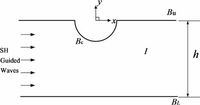Researchers have conducted an in-depth investigation into the effects of semicircular depressions in piezoelectric ceramic plates, shedding light on the factors that lead to dynamic stress concentration and electric field intensity concentration. These findings hold critical implications for the design and durability of structures utilizing piezoelectric materials.
Piezoelectric ceramics are lauded for their electromechanical coupling properties, making them invaluable in applications ranging from medical technologies to energy harvesting systems. However, the presence of defects in these materials, such as open holes, can lead to catastrophic failures. The recent study focuses on the effects caused by a semicircular depression, particularly the interplay between the electric and mechanical stresses borne by these materials.
Utilizing advanced methodologies such as the complex function approach and wave function expansion, the study quantifies the stress concentration factors associated with various parameters—including wave number, strip thickness, and the order of guided waves. The results revealed a significant disparity between the detrimental influence of the electric fields compared to mechanical stress, making it clear that attention must be paid to electric field intensities in designs incorporating piezoelectric ceramics.
Key findings illustrate that the electric field intensity concentration coefficient at the edge of the recess can be approximately 2.5 times larger than the dynamic stress concentration coefficient under specific conditions (h* = 3). This underscores the necessity of considering electric fields in formulations regarding the durability of piezoelectric elements.
Throughout the analysis, researchers determined that as the thickness of the piezoelectric plates increases, the stress concentration around defects diminishes. Notably, maximizing plate thickness limits the potential for damage from high-frequency guided waves. When guided wave orders increase, the impact on stress concentration can be profound, revealing the complex interactions of wave mechanics in piezoelectric systems.
The implications of this study extend beyond theoretical understandings. Enhanced knowledge of how these materials respond to stressors can directly translate into better engineering practices, promoting safety and efficacy in practical applications. For example, these insights could guide the design of ultrasonic devices in medical diagnostics, where precision is paramount.
In conclusion, this research serves as a cornerstone for future explorations into piezoelectric materials, emphasizing the importance of electric fields and their considerable effect on material integrity. As piezoelectric ceramics continue to permeate various sectors, from aerospace to renewable energy, experts recommend that engineers prioritize electric field effects to prevent catastrophic failures and enhance the longevity of devices.

